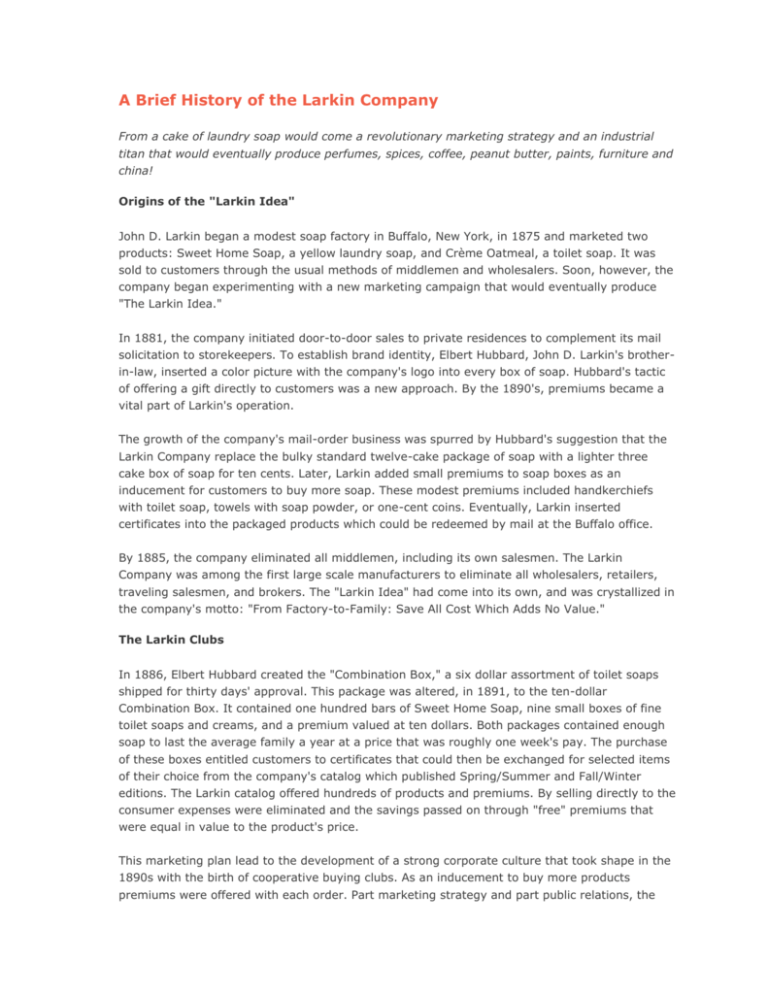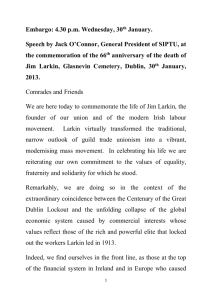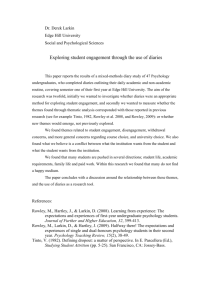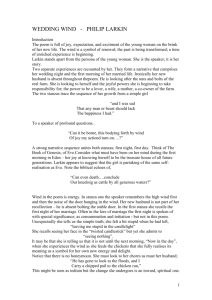reading - Larkin Center of Commerce
advertisement

A Brief History of the Larkin Company From a cake of laundry soap would come a revolutionary marketing strategy and an industrial titan that would eventually produce perfumes, spices, coffee, peanut butter, paints, furniture and china! Origins of the "Larkin Idea" John D. Larkin began a modest soap factory in Buffalo, New York, in 1875 and marketed two products: Sweet Home Soap, a yellow laundry soap, and Crème Oatmeal, a toilet soap. It was sold to customers through the usual methods of middlemen and wholesalers. Soon, however, the company began experimenting with a new marketing campaign that would eventually produce "The Larkin Idea." In 1881, the company initiated door-to-door sales to private residences to complement its mail solicitation to storekeepers. To establish brand identity, Elbert Hubbard, John D. Larkin's brotherin-law, inserted a color picture with the company's logo into every box of soap. Hubbard's tactic of offering a gift directly to customers was a new approach. By the 1890's, premiums became a vital part of Larkin's operation. The growth of the company's mail-order business was spurred by Hubbard's suggestion that the Larkin Company replace the bulky standard twelve-cake package of soap with a lighter three cake box of soap for ten cents. Later, Larkin added small premiums to soap boxes as an inducement for customers to buy more soap. These modest premiums included handkerchiefs with toilet soap, towels with soap powder, or one-cent coins. Eventually, Larkin inserted certificates into the packaged products which could be redeemed by mail at the Buffalo office. By 1885, the company eliminated all middlemen, including its own salesmen. The Larkin Company was among the first large scale manufacturers to eliminate all wholesalers, retailers, traveling salesmen, and brokers. The "Larkin Idea" had come into its own, and was crystallized in the company's motto: "From Factory-to-Family: Save All Cost Which Adds No Value." The Larkin Clubs In 1886, Elbert Hubbard created the "Combination Box," a six dollar assortment of toilet soaps shipped for thirty days' approval. This package was altered, in 1891, to the ten-dollar Combination Box. It contained one hundred bars of Sweet Home Soap, nine small boxes of fine toilet soaps and creams, and a premium valued at ten dollars. Both packages contained enough soap to last the average family a year at a price that was roughly one week's pay. The purchase of these boxes entitled customers to certificates that could then be exchanged for selected items of their choice from the company's catalog which published Spring/Summer and Fall/Winter editions. The Larkin catalog offered hundreds of products and premiums. By selling directly to the consumer expenses were eliminated and the savings passed on through "free" premiums that were equal in value to the product's price. This marketing plan lead to the development of a strong corporate culture that took shape in the 1890s with the birth of cooperative buying clubs. As an inducement to buy more products premiums were offered with each order. Part marketing strategy and part public relations, the customer now felt like a member of the Larkin family and was referred to as a "Larkinite". The "Larkin Club" was established enabling the customer to purchase items on the installment plan. It became the heart of the mail order business and a key to the company's success. Ten housewives would form a club and each contribute a dollar monthly. Club members were mostly from small towns whose families had modest incomes. The "secretary" organized the club and conducted business with Larkin offices on behalf of all members. The secretary purchased a Combination Box and the products and premiums were distributed among the club members. Some 'secretaries' even won trips to visit the factory based on their sales volume. The "Larkin Club of Ten" helped the Company survive the panic of 1893. Sales boomed from $220,000 in 1892 to $15 million by 1906. Larkin products and premiums made it possible for customers to furnish their homes, stock their pantries, and clothe their children. The company referred to the clubs as the highest and most popular development of the Larkin Idea. Expansion and Diversification After 1900, Larkin expanded its product offerings beyond soaps and related products to include packaged foods and numerous household products. Products were manufactured under strict purity conditions and the Larkin Company considered themselves the "pure food specialists". Between 1901 and 1909, as its premium business blossomed, it began purchasing manufacturing facilities that produced pottery, glassware, leather, and furniture. The Larkin Company also opened branch offices and showrooms in and near major urban centers on the East Coast and in the Midwest. To reach small towns east of the Mississippi River, it dispatched rail cars that contained fully stocked showrooms to excite interest in the company's products and buying clubs. The Larkin Administration Building At the heart of the physical presence of the company was the Larkin Administration Building, designed by Frank Lloyd Wright and constructed in 1906. It proved the success of the Larkin Idea and ushered in the glory years of the company. This red brick building was five stories tall and was intended to be both practical and yet convey the humane principles of John D. Larkin. The interior contained an open five story courtyard surrounded by balconies. The building contained a kitchen and dining rooms, classrooms and a branch of the Buffalo Public Library in addition to a pipe organ. Wright designed the natural and artificial lighting and also the electrical fixtures and furniture. Located in a noisy and sooty industrial area of Buffalo, the building was hermetically sealed and lighted mostly from skylights. Advanced heating and ventilation systems, including one of the earliest forms of air conditioning, provided comfort to the office. The principal mail order activities occurred on all floors, except the top, which housed kitchen facilities. Larkin executives occupied the main floor. This unique arrangement left the executives with no privacy and without the status conferred by being allotted space on the top floor of an office building. The unorthodox seating arrangements were consistent with the image Larkin wanted to project of open, familial relations. In 1950, the City of Buffalo ordered the structure demolished due to owed back taxes. Some considered it to be one of America's worse man-made architectural disasters. Employee Programs and Office Culture Employment at the Larkin Company boomed, reaching a peak in 1919 of almost 4,500 people, with 2,200 in the Buffalo factory complex. Sixty-four percent of the total workforce was comprised of young, single women. John D. Larkin's religious background inspired his paternalistic views toward his employees which resulted in many innovative programs and benefits. He built only fireproof structures, increased office capacity, and installed a new ventilation system. In 1900, the company reduced factory hours from nine hours and forty minutes to nine hours and by 1901, to eight and half hours. The Company was a pioneer in employee benefit programs offering such services as: paid vacations to longtime and meritorious employees (1900), an employee thrift plan (1901), free coffee for employees (1901), a lunch cottage (1903), and the first company picnic (1903). In 1903, the company inaugurated a monthly company magazine called "Ourselves" that not only advertised the Larkin Company's benefits, but also attempted to develop a better employee work ethic and worker relations. In 1905, the Larkin Company created its own branch of the Young Women's Christian Association (YWCA). In 1907, Larkin Company created an education department and opened a branch of the Buffalo Public Library on the premises. In the same year, it sponsored a company-wide educational reimbursement plan for self-improvement. In 1918, the Larkin Company encouraged employees to attend night schools. The Company also claimed to be a pioneer in "Americanization" classes, developed during World War I for its growing immigrant factory workforce. In May 1906, the Larkin Company established the Larkin Benefit Association as a self-help plan to provide financial benefits to Larkin employees in cases involving sickness, need, and death. Other financial benefits were later added such as a life insurance program(1923), the Larkin Men's Club Gratuity Fund (1931), the Larkin Employees' Credit Union (1933), and hospital insurance (1937). An employee stock-based ownership plan was introduced in the 1920's but failed due to a number of problems. Larkin Company hired a trained nurse in 1905. Both the office and factory had medical facilities and rest rooms for employees. The Larkin YWCA maintained rooms in local hospitals for ailing women. In 1915, the company opened a modern dental office that provided a variety of services at nominal prices. The Company provided comfortable lounges and rest rooms, a gym, showers, lockers, and a large restaurant. Additional restaurants opened as the workforce expanded. Social activities, including recreation, sports, and employee clubs, were integral parts to Larkin's corporate culture and to foster a spirit of teamwork. The activities and clubs provided employees with much-needed leisure time and opportunities to form social bonds with other employees and managers. These clubs included basketball, bowling, and baseball. Larkin teams competed in industrial and citywide leagues and in local and national bowling tournaments. Demise of the Company The growth of department stores, the popularity of the automobile and the volatility of the marketplace, especially during the Great Depression, damaged the Larkin Company's mail order business. Larkin's diversification into its own chains of retail food markets, gasoline stations, home craft stores, and a department store did not revive the company. The loss of key executives due to retirement or death and internal struggles among the next generation of Larkin executives, hurried the demise of the company. Sales fell from $28.6 million in 1920 to $2 million by 1939 and the Company ceased operations in the 1940's. Darwin Martin and Elbert Hubbard Starting as a book keeper, Darwin Martin eventually became corporate secretary (today's version of chief operating officer) and guided the company through its rise to a local corporate heavyweight. He created a unique card ledger system for tracking sales and maintaining accounts which is utilized by many corporations, in various formats, to this day. Most notably, he commissioned his friend, Frank Lloyd Wright, to design the Larkin Administration Building and his house in Buffalo and a summer home called Graycliff. Elbert Hubbard was the brother-in-law of John D. Larkin who created the "Combination Box." It was this revolutionary marketing scheme that fueled the growth of the Larkin Company taking it from a soap manufacturer to a corporate power. Retiring from the company in 1893, he eventually founded the Roycrofters in East Aurora, NY. Source: monroefordham.org/../history.htm






